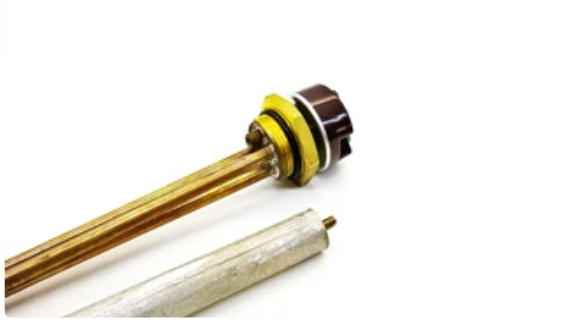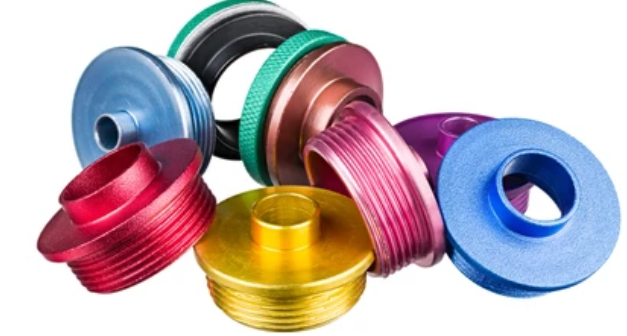陽極酸化とは、金属表面に酸化層を形成して錆びを防ぐことです。. このほかにも, 耐摩耗性を強化し、塗料や接着剤に対する表面の接着力を向上させます。. 陽極酸化はほぼすべての業界で行われています, つまり. 航空宇宙, 自動車, 電子, と建築.
この記事では、さまざまな種類の陽極酸化処理について説明します。, いくつかの例外的な機能, 最適な陽極酸化処理の種類を決定する方法. 陽極酸化は、アルミニウムおよびその他の関連金属の特性を改善するための一般的で有用な表面仕上げ技術です。.
さまざまな種類の陽極酸化処理
それで, 以下は使用できるさまざまな種類の陽極酸化処理です:
1. タイプI: クロム酸アルマイト処理
クロム酸陽極酸化処理により、本体に陽極酸化された薄い酸化皮膜が形成されます。 アルミニウム 高い耐食性を持っています. サイズの変化が少なく、耐食性に優れているため、航空宇宙産業でより一般的に使用されています。. このプロセスは空気や薄肉部品に適していますが、他のタイプほど高い耐摩耗性はありません。.
2. タイプⅡ: 硫酸陽極酸化処理
硫酸陽極酸化処理により、タイプ I よりも厚い酸化皮膜が形成されます。, 良好なレベルの腐食とかなり優れた摩耗保護を提供します。. 一般産業用に広く適用可能, 自動車, および消費者製品の使用. 色を付けることもでき、用途や製品の外観に合わせてさまざまな色を選択できます。.
3. タイプⅢ: 硬質アルマイト処理
硬質アルマイト処理, 一方で, さらに高い電流密度で発生し、硫酸を使用して陽極酸化層を厚くするため、最大の耐摩耗性と耐腐食性を提供することが難しくなります。. 機械部品や装置などの製造業での使用に最適です。, そして軍隊の生産, 高い摩擦耐性と高い耐摩耗性、耐引裂性が必要な場合.
4. タイプ IV: 染料アルマイト処理
この方法のタイプ II 陽極酸化は染料陽極酸化と密接に関連しています。, 表面に明るく豊かな色を与えます. このプロセスは、多孔質酸化物層を利用して染料を取り込み、腐食防止の機能に加えて金属表面の表面的な外観を追加します。. 消費財の分野で装飾コーティングとして広く応用されています。, エレクトロニクス, そして建設.
5. タイプV: リン酸アルマイト処理
リン酸陽極酸化処理により、異なる種類の酸化皮膜が生成されます。 アルミニウムプロファイル; 塗料やコーティングに最適なより粗い層. 名前が示すように、この方法は、さらに塗布されるコーティングまたは潤滑剤の密着性を向上させることが望ましい場合に推奨されます。. 通常、航空宇宙産業で腐食保護や追加の表面コーティングが必要な部品に使用されます。.
6. チタンアルマイト処理
チタン陽極酸化はアルミニウム陽極酸化に似ていますが、印加される電圧に応じてさまざまな色が可能な点が異なります。. 安定した酸化皮膜を形成し、優れた耐食性を発揮します。; この金属は航空宇宙でよく使用されます, 医学, 他の装飾用途に沿って; 明るい色の色合いのため.
7. マグネシウム陽極酸化処理
マグネシウムの陽極酸化は通常、アルカリ溶液を使用して行われ、マグネシウム合金の表面に酸化マグネシウムの一体層を形成します。. 航空宇宙で使用されるマグネシウム部品を保護するために陽極酸化処理されます。, 軍隊, マグネシウムの反応性の性質のため、このプロセスはわずかにまれで困難ですが、自動車用途にも使用されます。.
8. 航空機用硬質コアルマイト処理 (MIL-8625)
この特定の陽極酸化プロセスは軍用規格を満たしており、主に航空宇宙産業や防衛産業向けにアルミニウム合金上に厚さの陽極酸化膜を製造するために採用されています。. 超合金は優れた摩耗性と耐腐食性を提供します, したがって、過酷な使用環境にある要求の厳しい軍事部品を顧客に提供します。.
陽極酸化プロセスを段階的に完了する
陽極酸化皮膜は、硬質な金属表面を形成することで金属表面を変化させます。, 防食酸化物層. 各段階の詳細な内訳は次のとおりです:
1. 表面処理
の 陽極酸化処理 金属、または最も好ましくはアルミニウムの表面を、洗浄とエッチングを含む非常に特殊な方法で処理することから始まります。. このステップでは、表面を洗浄または洗浄して、陽極酸化プロセスから不要な物質を除去し、アルミニウム表面に均一なコーティングを形成します。. これが、きれいな表面がより優れた酸化層を与え、優れた仕上げをもたらす理由です。.
2. 陽極酸化浴
清掃後, 金属は硫酸またはクロム酸などの酸性電解質システムに置かれます。. 溶液に直流電流を流す, 金属表面は望ましいメカニズムに従って電子的に腐食されます。. この反応により安定した物質が形成されます。, 酸化鉄層は基本的に金属表面の一部であり、強度が向上し、金属の耐用年数が長くなります。.
3. 着色 (オプション)
アルマイト処理後に着色効果が必要な場合, 染料または顔料を陽極酸化層に組み込むことができます. この酸化層には細孔がたくさんあり、これらの顔料がしっかりと結合することができます。, こうして、長く続くものをたくさん生み出します。, 表面の明るい色.
4. シーリング
ほとんどの入れ歯で行われる最後のプロセスはシーリングです。. 陽極酸化層の細孔は閉じているため、摩耗から安全であり、金属に腐食が浸透しにくいため、適用された色はそこに留まることができます。. これは、熱水または化学薬品を使用してシールすることができ、より優れた、より長いエンドシールを実現します。.
コーティング厚さ対. アルマイト処理時のコーナー半径
アルマイト処理中, コーティングの厚さとコーナー半径は連動しています, これら 2 つの要素は、最終製品の効率と外観を定義するのに役立ちます。. 硬さ用, 厚みがあるため、腐食や一般的な摩耗に対する保護が向上します。, どれが理想的ですか. しかし, 大規模に, エッジに大きな堆積物が発生することを歓迎します, 鋭角が含まれるため、丸くなったり不均一になったりします。. 鋭い角では酸化物層が薄くなったり、不均一になったりすることができないため、コーティングの均一性に関しては、角の半径が大きい方が好ましいです。.
保護と耐久性を最大限に高め、適切な品質基準を達成するため, 特に機能的または美的用途において, コーティングの厚さはコーナーの半径に比例する必要があります. 最後のコーナーの半径は、コーナー全体を均一に保護しながら適切なコーティング厚さを確保できるように選択する必要があります。, 丈夫な, そして美的に魅力的です.
適切な陽極酸化処理のタイプを選択するために考慮すべき重要な要素は何ですか
適切な種類の陽極酸化処理を選択する際に留意すべきいくつかの事実を以下に示します。:
- 申請要件: 必要な耐食性に応じてさまざまな種類の陽極酸化処理が存在します, 耐摩耗性, または装飾目的.
- コーティングの厚さ: それらのタイプは次のことをもたらします: 皮膜のアルマイトの厚さは種類によって異なります, コーティングの耐久性と保護を決定します.
- 環境暴露: 強酸性などの部品に影響を与える可能性のある化学範囲などの条件を考慮する, 高アルカリ性, または非常に暑いまたは寒い.
- 材質の適合性: 陽極酸化プロセスが特定の金属(主にアルミニウム)に適切であることを確認してください。, チタン, そしてマグネシウム.
- 美的嗜好: 陽極酸化タイプでは着色が可能であり、美観を必要とする製品に必要となる場合があります。.
陽極酸化処理のメリット
正しいタイプの陽極酸化処理を選択するのに役立つ、陽極酸化処理の利点をいくつか紹介します。:
- 耐食性の向上: 金属のかぶれやサビを防ぎます.
- 耐久性の向上: 耐久性があり、耐摩耗性の高い表面を実現する傾向があります。.
- 美的魅力: さまざまな色の選択肢があります.
- 環境に優しい: 陽極酸化処理は有害なVOCを生成しません, アルミニウムの中でも環境に優しい表面処理方法として広く考えられています。.
- 電気絶縁: 必要な場合、または材料の導電性が必要ない場合に、絶縁材料を使用して作業するのに適しています。.
陽極酸化の限界
陽極酸化プロセスによって生じるいくつかの課題は次のとおりです:
- 厚い層の脆性: 厚い層はバイスタックになる可能性があることも確認されました, つまり, 不均質な構造は応力下では脆くなる.
- 硬質陽極酸化処理の限られた色のオプション: 硬質陽極酸化処理された表面には、さまざまな色の可能性があるという利点があります。, 数は少ないですが.
- プロセス固有の制限: しかし, 特定の種類の金属と形状は陽極酸化が困難です.
- 環境への配慮: 酸やアルカリにさらされやすいタイプもあります。.
- 初期費用が高い: アルミニウムの陽極酸化は、アルミニウムを他の製品に変換する必要がある他のプロジェクトに比べて比較的コストがかかります.
陽極酸化処理の応用例
以下は、さまざまな産業用途におけるさまざまな種類の陽極酸化処理の用途です。:
- 航空宇宙部品: 軽量かつ耐食性を備えた航空・宇宙用平面構造用部品.
- 自動車部品: 部品の磨耗やトリムに対する耐久性の高い出力.
- 家電: 傷防止, スタイリッシュなハウジング, そしてカバー.
- 建築: 構造物を錆やその他の種類の腐敗から保護するコーティング, 装飾用の器具と一緒に.
- 医療機器: 掃除のしやすさと製品の寿命の延長の両方を実現.
結論
陽極酸化は、アルミニウムやその他の金属の特性を向上させるための多用途で価値のある仕上げプロセスです。. 適切な種類の陽極酸化処理を選択することで、最適な硬度を得ることができます。, 最高レベルの腐食保護, 特定のアプリケーションに対する望ましい見通し. タイプI, タイプⅡ, この場合、タイプ III とタイプ III が利用可能なオプションであり、それぞれに利点がありますが、プロジェクトの要件を考慮することが重要です。. 陽極酸化は金属部品の寿命を延ばすだけでなく、多くの分野で美的コーティングの機会をもたらします。.
よくある質問
陽極酸化できる金属は何ですか?
現在のところ, アルミニウムは陽極酸化の母材として広く使用されていますが、チタンやマグネシウムも陽極酸化できます。.
陽極酸化はどれくらい持続しますか?
陽極酸化処理は、種類と用途に応じて 3 ~ 5 年間持続します。, 過酷な環境にさらされると.
アルマイトの表面に塗装はできますか?
はい, 陽極酸化表面は多孔質であるため、良好な塗装および接着被着体の特性を備えています。.
陽極酸化は環境に優しいプロセスです?
陽極酸化処理は環境に分解されず、危険な副生成物が残りません。.
陽極酸化皮膜は修復できますか?
陽極酸化処理された表面は、部品が損傷した場合に陽極酸化処理を剥がして再堆積することができます。. しかし, 部品の寸法が影響を受けます.
アルマイト処理と粉体塗装はどう違うのか?
陽極酸化は金属をコーティングするプロセスであり、金属の一部を形成しますが、パウダーは外側のコーティングであり、摩耗と耐久性に影響します。.
Type III 陽極酸化処理は美観関連のプロセスには使用できません?
タイプ III は主にこのタイプの用途に使用されますが、色の種類が限られているため、審美的な目的で数回のみ使用されます。.














1 「」について考えました陽極酸化処理の種類について知っておくべきことすべて”